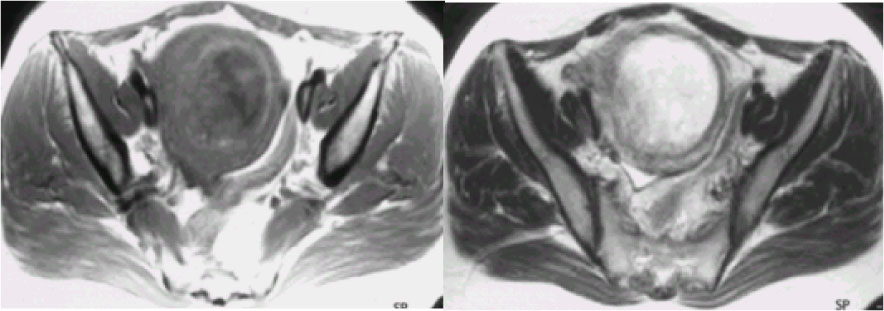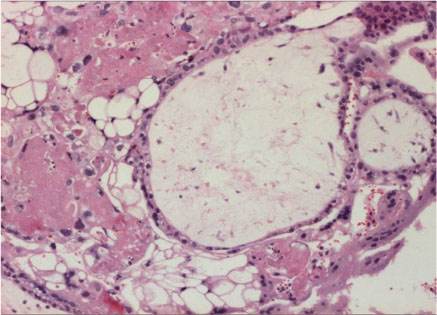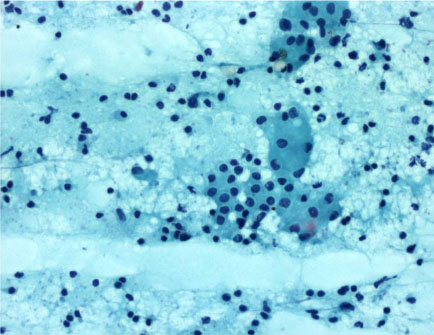J Korean Soc Endocrinol.
2005 Jun;20(3):294-298. 10.3803/jkes.2005.20.3.294.
A Case of Hashimoto's Thyroiditis with Transient T3-Thyrotoxicosis Induced by Hydatidiform Mole
- Affiliations
-
- 1Department of lnternal Medicine, College of Medicine, Hallym University, Chunchon, Korea.
- 2Department of Pathology, College of Medicine, Hallym University, Chunchon, Korea.
- KMID: 2200572
- DOI: http://doi.org/10.3803/jkes.2005.20.3.294
Abstract
- Human chorionic gonadotropin(HCG) is a member of the glycoproteins family synthesized by the placenta, which consists of 2 noncovalently joined subunits(alpha(alpha) and beta(beta)). The alpha- and beta-subunits have a structural homology with the alpha- and beta-subunits of TSH and LH. The thyrotropic action of HCG results from its structural similarity to TSH, so beta-HCG can bind to the TSH receptor in the thyroid gland. A high level of HCG accompanied by an increased thyroid hormone level, can be observed in gestational trophoblastic disease (GTD), such as a hydatidiform mole or a choriocarcinoma, but the clinical symptoms of hyperthyroidism are rarely observed. We experienced a case of Hashimoto's thyroiditis, where the patient was diagnosed with T3-thyrotoxicosis, which had initially been induced by excess beta-HCG due to an H-mole; after evacuation of the H-mole, the condition was diagnosed as hypothyroidism. It has been speculated that a patient with Hashimoto's thyroiditis could have hyperthyroidism, induced by beta-HCG, due to an H-mole
MeSH Terms
Figure
Reference
-
1. Tisne L, Barzellato J, Stevenson C. Study of thyroid function during pregnancy and the postpartum period with radioactive iodine. Bol Soc Chil Obstet Gynecol. 1955. 20:246. Cited form 23.3. Yoshimura M, Hershman JM. Thyrotropic action of human chorionic gonadotropin. Thyroid. 1995. 5:425–434.4. Azukizawa M, Kurtzman G, Pekary AE, Hershman JM. Comparison of the binding characteristic of bovine thyrotropin and human chorionic gonadotropin to thyroid plasma membranes. Endocrinology. 1977. 101:1990.5. Carayon P, Lefort G, Nisula B. Interaction of human chorionic gonadotropin and human luteinizing hormone with human thyroid membranes. Endocrinology. 1980. 106:1907.6. Nisula BC, Taliadouros GS. Thyroid function in gestational trophoblastic disease: evidence that the thyropropic activity of chorionic gonadotropin mediates the thyrotoxicosis of choriocarcinoma. Am J Obstet Gynecol. 1980. 138:77–85.7. Kenimer JG, Hershman JM, Higgins HP. The thyrotropin in hydatidiform moles is human chorionic gonadotropin. J Clin Endocrinol Metab. 1975. 40:482.8. Hershman JM. Physiological and pathological aspects of the effect of human chorionic gonadotropin on the thyroid. Best Pract Res Clin Endocrinol Metab. 2004. 18:249–265.10. Fantz CR, Dadago-Jack S, Landerson JH, Gronowski AM. Thyroid Function during Pregnancy. Clinical Chemistry. 1999. 45(12):2250–2258.11. Hershman JM. Human chorionic gonadotropin and the thyroid: hyperemesis gravidarum and trophoblastic tumor. Thyroid. 1999. 9:653–657.15. Hershman JM. Braverman LE, editor. Trophoblastic tumor. The thyroid. 2004. 9th ed. Philadelphia: Lippincott Williams & Wilkins;519–523.
- Full Text Links
- Actions
-
Cited
- CITED
-
- Close
- Share
- Similar articles
-
- A Case of Transient Thyrotoxicosis Associated with Acute Hemorrhagic Necrosis of a Thyroid Nodule
- Progression of Hashimoto’s Thyroiditis to Graves’ Disease: a Report of Two Pediatric Cases
- A Case of Hashimoto's Thyroiditis Presented with Severe Hypertension and Thyrotoxicosis
- A Case of Thyrotoxic Periodic Paralysis Associated with Transient Thyrotoxicosis
- A Case of Ectopic Hydatidiform Mole in the Uterine Cornua





